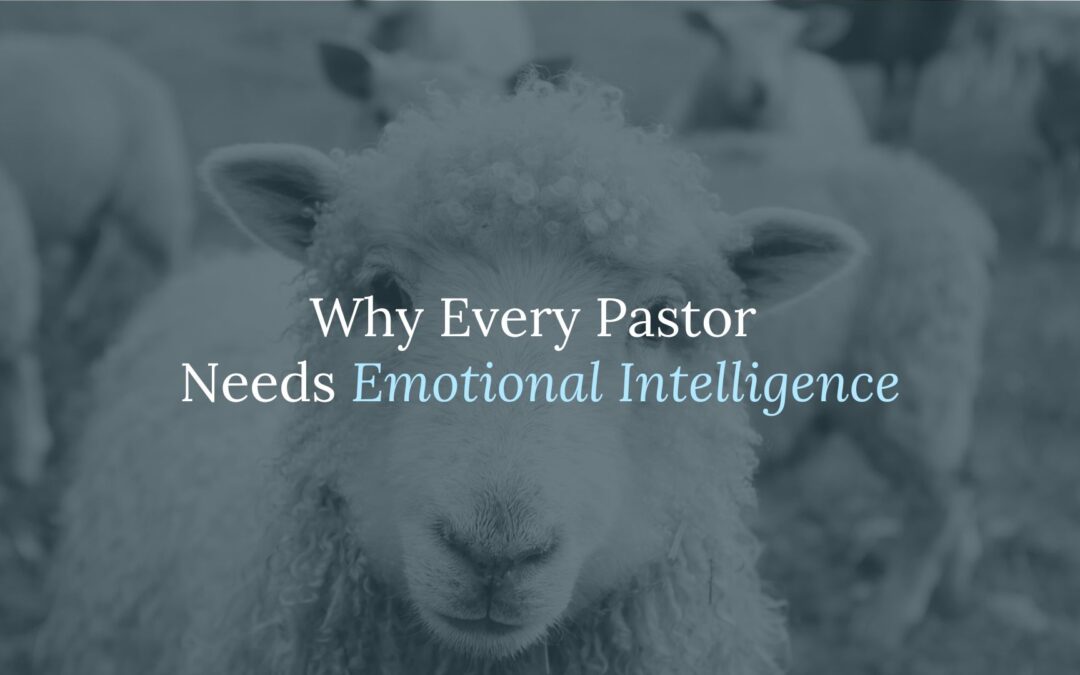
by Stephen Hay | May 23, 2025 | Spiritual Formation, Church Health, Leadership
Ministry leader, may I ask a tender but urgent question?
When was the last time you looked at the people in your congregation and thought, We are stewarding their gifts well?
If you hesitated, you’re not alone. But perhaps more importantly, if we don’t know how to answer that question, we may be missing the means God gave us to build His church.
In a time when attendance feels fragile and volunteers feel few, it’s easy to believe the lie that people aren’t interested in serving. But what if the problem isn’t a lack of willingness, but a lack of clarity?
The Church Isn’t a Stage—It’s a Body
The Apostle Paul reminds us: “Now there are varieties of gifts, but the same Spirit… to each is given the manifestation of the Spirit for the common good.” (1 Corinthians 12:4,7)
Note Paul’s words: to each is given.
There is no Christian on the sidelines of God’s mission—unless we put them there. The Holy Spirit has assigned gifts to every believer, not just for their fulfillment, but for the strengthening of the whole church. When we fail to help people identify and activate those gifts, we cut off the supply chain of the Spirit’s power meant to flow through His people.
This is not just bad leadership—it’s poor stewardship.
We Don’t Have a Volunteer Shortage—We Have a Vision Shortfall
Consider this:
85% of born-again adults have heard of spiritual gifts.
Yet nearly half, 46%, say they don’t know what their gift is, or believe they don’t have one at all.
And even among those who claim to know, only 30% can identify a biblically rooted gift. The rest either misidentify personality traits as gifts or can’t describe how their gifts are being used in the church today.
These aren’t stats to shrug at. They are a flashing warning that we’ve taught church membership without discipleship, and celebrated involvement without discernment.
Gift Awareness Fuels Spiritual Growth
Let me encourage you with this: helping people understand and deploy their spiritual gifts is not a leadership tactic—it’s a discipleship practice.
When believers are given language for how God has wired them, they begin to walk with fresh confidence in their identity in Christ. In fact, 82% of self-identifying Christians say that developing their gifts draws them closer to God. Among practicing Christians, that number rises to 97%.
Can you see the beauty? Teaching gifts don’t just get people into service—they get them deeper into Christ.
Gift Clarity Builds the Church (and Prevents Burnout)
Here’s what pastors often miss: when we fail to identify gifts, we default to filling holes. The most eager volunteers tend to receive the most tasks. Those who aren’t upfront or outspoken get overlooked. And we silently assume that “availability” is the same as “anointing.”
But what if, instead, we took time to discover who God has already placed in the room?
What if we said: No one does everything, but everyone does something. And we will help you find that something.
Churches that teach and deploy spiritual gifts experience up to a 35% greater retention of volunteers. They grow more sustainably. And more importantly, they bear fruit that lasts.
Pastor, Start With Yourself
Before you go searching your congregation for gifts, ask yourself: Do I know my own?
Your ability to lead with clarity depends on knowing how the Spirit has equipped you, not just as a shepherd, but as a part of the body. Knowing your gift mix humbles you, keeps you from over-functioning, and frees you to make space for others to lead.
Let the work begin with you. Then create a culture where others can follow.
Next Steps, Not Guilt Trips
This isn’t a call to do more—it’s a call to see differently. The Spirit has already done the heavy lifting. You’re simply called to steward the gifts He’s entrusted to your flock.
So ask the questions:
- Do we teach about spiritual gifts with biblical clarity?
- Do we help people discover and discuss their gifting?
- Do our ministries align with the gifts God has actually given?
- Do our people feel celebrated and developed, or just used?
Because if every member has been gifted for the common good, then the church has already been equipped to flourish.
We just need to unearth what’s been buried.
And then—by God’s grace—fan it into flame.

by Stephen Hay | May 23, 2025 | Leadership, Spiritual Formation
Because the Heart Can’t Shepherd What It Can’t See
“Keep watch over yourselves…”
Before Paul says “and all the flock,” he says yourselves.
Acts 20:28 isn’t subtle. And yet, how many of us in ministry have spent years watching the sheep, but not our souls?
We prepare sermons and lead meetings, cast vision and resolve conflict, all while ignoring the emotional dashboard that’s quietly blinking ‘overload.’ Or worse—numb.
And here’s what we know, if we’re honest:
We’ve mastered the art of appearing unshakeable… even when we’re spiritually and emotionally threadbare.
That’s where Emotional Intelligence (EQ) comes in—not as a buzzword, but as a biblical tool.
What Is EQ—and Why Should Pastors Care?
Emotional Intelligence is the ability to recognize, understand, and manage your own emotions—and the emotions of those around you. It isn’t sentimentality. It’s soul-wisdom in real time.
In modern terms, EQ includes five key areas:
- Self-awareness
- Self-regulation
- Motivation
- Empathy
- Social skills
In biblical terms? It bears a strong resemblance to the fruit of the Spirit. It sounds like James: “Be quick to listen, slow to speak, slow to become angry.” It smells like Christ.
The Data Is Clear: EQ Is Ministry Survival Gear
Let me show you just how critical EQ is for pastoral leadership:
- Burnout is on the rise. Over 40% of pastors are now at high risk—up 400% since 2015. But research shows that pastors with high EQ experience far lower burnout across every measure.
- Leadership effectiveness increases. One study of executive pastors showed that EQ alone explained 42% of their perceived effectiveness. That’s nearly half.
- Conflict is handled better. Emotional intelligence equips us not to avoid conflict (a temptation in ministry), but to transform it—through empathy, regulation, and wise timing.
- Job satisfaction and team morale rise. EQ doesn’t just change how you feel—it shapes how your entire staff team functions, collaborates, and grows.
- Christ-like leadership becomes visible. Congregations don’t follow charisma—they follow character. Emotional maturity isn’t optional for a shepherd. It’s essential.
The Gospel Requires a Self-Aware Shepherd
We are not called to be perfect, but we are called to be present—to ourselves, to our people, and to the Lord.
Jesus knew His emotional state. He wept. He grieved. He rejoiced. He questioned in the garden and showed compassion in the crowd. He lived with a holy awareness, even in the midst of anguish. So must we.
As pastors, we are not exempt from the need for emotional growth. We are stewards of it.
To know God more deeply is to know ourselves more clearly—not to obsess over our feelings, but to recognize that unacknowledged emotions don’t disappear; they disciple us in the dark.
Five Questions Every Pastor Should Ask:
- When was the last time I named what I was feeling, without spiritualizing it?
- Do I know how my mood shapes the tone of our meetings or sermons?
- Can I listen to criticism without spiraling or retaliating?
- Do I sense emotional shifts in others, or only react when it’s “too late”?
- Am I modeling emotional maturity for my staff, family, and church body?
This Is Discipleship, Too
Let’s stop calling it “soft skills.” Emotional Intelligence is spiritual formation. It is leadership fidelity. It is how we shepherd hearts, starting with our own.
So, to my fellow pastors and ministry leaders:
Don’t wait for a breakdown to start paying attention to your inner life.
Don’t assume high theology cancels out low awareness.
And don’t believe the lie that burnout is a badge of honor.
Start today. Be honest with yourself. Ask your spouse. Take the Emotional Intelligence assessment. Find a coach. Read the Psalms with fresh eyes—not just for inspiration, but for instruction.
We are not merely sermon-deliverers. We are soul-shepherds.
And the best shepherds know when their own soul needs tending, too.
Let the gospel shape you—emotionally, relationally, and deeply.
Because the health of the church often reflects the health of its shepherd.
And healing always starts with honesty.
“Above all else, guard your heart, for everything you do flows from it.”
— Proverbs 4:23

by Stephen Hay | Apr 25, 2025 | Spiritual Formation, Leadership
I used to think stress was the enemy.
Like many pastors, I assumed that when my chest tightened and my to-do list felt like it had teeth, I was somehow doing it wrong—living outside God’s best, missing some secret formula for “peace that surpasses understanding.” Stress, I believed, was a neon sign flashing Failure! over my life.
But recently, I learned something that turned that assumption upside down.
I stumbled across the difference between distress and eustress—two words that describe two very different stories that stress can tell. It was Hans Selye, a scientist in the 1970s, who first named them. Distress is the story most of us know: the grinding, overwhelming kind of stress that erodes hope and health. But eustress (from the Greek word for “good”) is a different tale altogether—it’s the energizing, growth-stretching kind of stress that actually strengthens you.
It hit me hard:
Stress isn’t always the enemy. Misinterpreted stress is.
A Different Kind of Fight
As I dug deeper, I learned that the key difference between distress and eustress isn’t the size of the problem. It’s the way our hearts appraise it.
When a challenge feels bigger than our resources, it mutates into distress. But when a challenge feels just within reach, it sparks eustress—fueling learning, resilience, even joy. In God’s kindness, our bodies are wired to handle both—but they thrive when we name the story rightly.
And here’s where it got personal.
I thought about the new ministry initiatives we were launching—the way excitement had so quickly soured into sleepless nights, tangled in what-ifs and worst-case scenarios. Distress had been gnawing at me, not because the task was inherently bad, but because somewhere along the way, I had lost the perspective that God equips those He calls. I had stopped seeing the opportunity and only saw the threat.
Choosing to Reframe
One small but profound practice I’ve started since is learning to reframe stressful situations intentionally—right there in the moment. When a heavy meeting or a tight sermon deadline looms, I now ask myself:
“Is this a threat—or a stretch?”
“Is God exposing my weakness to shame me—or inviting me to trust Him for more?”
It’s startling how often my gut response changes. What once felt like distress now feels more like holy eustress—a chance to lean harder on the Spirit and discover new muscles I didn’t know I had.
I also started building small recovery rhythms into my days: pausing for prayer after long meetings, taking five-minute walks between writing sprints, practicing actual Sabbath instead of “crash-and-binge” days off. Those tiny margins aren’t indulgences. They are what allow eustress to sharpen me without tipping into burnout.
A Takeaway for the Weary Leader
If you’re reading this, weighed down under the demands of ministry, let me remind you:
Stress is not a sign you’re failing. It may be the sign you’re growing.
The enemy would love to convince you that every heavy moment is a sentence of doom. But Scripture reminds us:
“We are hard pressed on every side, but not crushed; perplexed, but not in despair…” (2 Corinthians 4:8)
In Christ, even our pressure points become places of renewal.
The challenge is not to eliminate stress (an impossible goal) but to rightly interpret it—to ask what kind of story it’s telling, and who’s holding the pen.
So the next time your heart races before you step into a hard conversation, or your mind spins with deadlines and sermons and counseling appointments, pause. Take a breath. Name the moment:
“This isn’t a threat. It’s an invitation.”
And walk forward with hope.
God is not just the God of peace in our stillness.
He is the God of strength in our striving.
And remarkably, He uses even the pressures of ministry—not to crush us—but to carve us more fully into the likeness of Christ.
May we be those who see God’s hand even in the weight, and who trust that in every pressure, He is making us more like His Son.

by Stephen Hay | Mar 24, 2025 | Spiritual Formation, Cultural Trends
Leading in a Time of Change
As a pastor, I often find myself reflecting on how to better connect with and guide my congregation. The cultural tides are shifting rapidly, and as leaders of faith communities, we must stay attuned to these changes if we hope to shepherd well into the future.
This past week, I spent time engaging with two significant research efforts from the Barna Group: their State of the Church 2025 initiative and the newly released Gen Z Volume 3. What I discovered was both enlightening and challenging—offering timely insights into the evolving landscape of church life and the spiritual hunger of the next generation.
A Glimpse into the Future Church
Barna’s State of the Church 2025 offers a compelling forecast of where the church is headed. At first, I met the data with some skepticism—wondering how charts, graphs, and statistics could fully capture the spiritual heartbeat of a congregation.
Yet as I read deeper, I was surprised by how closely the report echoed what I’ve observed in my own ministry. It spoke of:
- A continued shift toward digital engagement
- A growing hunger for authentic community
- An urgent need for spiritual transparency and depth
These aren’t just distant trends—they’re realities we are already experiencing. The data validated the undercurrents I’ve sensed among those in the pews.
The Call for Spiritual Authenticity
What struck me most was the emphasis on spiritual authenticity. Time and again, I see people—young and old alike—longing for a faith that’s real, raw, and deeply personal. Barna’s research confirmed that this desire is not isolated; it’s widespread.
This insight challenged me to ask: How are we creating spaces for authenticity in our churches? Are we giving people permission to wrestle, ask questions, express criticisms and doubt without fear?
For our ministry, this means moving beyond surface-level engagement and building a culture that nurtures honest faith journeys.
Understanding Gen Z: A Generation of Opportunity
Next, I turned to Gen Z Volume 3. My initial feeling was a mix of curiosity and caution. Gen Z is often described as complex, digital-first, and emotionally attuned. Could we really meet them where they are?
Barna’s report made it clear: this generation is seeking emotional health, meaningful connection, and spiritual authenticity. They are not disengaged—they’re searching. But they want to engage on relational, truthful terms through formats that reflect their world.
Rethinking Ministry for a New Generation
This realization led to some practical thoughts. What if we started piloting scripture-saturated small group sessions focused on storytelling, vulnerability, and the real-life application of faith. These aren’t programs designed to entertain; they’re meant to build trust and make space for real conversations.
Young people want to talk—they just need to know we’re listening.
Insights as Tools, Not Templates
Both Barna reports offered more than statistics—they offered a roadmap for ministry. They reminded me that effective leadership today requires more than tradition; it requires curiosity, adaptability, and a willingness to learn.
As pastors and ministry leaders, we must approach cultural shifts not as threats but as Good News opportunities. Invitations to rethink, relearn, and reimagine how we disciple others in a rapidly evolving world.
Moving Forward with Courage and Grace
In the busyness of weekly sermons and pastoral responsibilities, it’s easy to overlook broader trends. But if we hope to shape churches that endure and flourish, we must take time to reflect, learn, and adapt.
So, what’s the takeaway?
Let’s not fear change—let’s engage with it. Let’s use insights like those from the Barna Group as tools to better understand the people we serve. And above all, let’s lead with love.
In writing this, I’ve found renewed inspiration. I’m reminded that we are not just caretakers of tradition—we are co-creators of the church’s future. May we step into that calling with open hands, willing hearts, and the courage to lead well.

by Stephen Hay | Feb 26, 2025 | Eternity, Spiritual Formation
This morning, as I opened Desiring God, a particular article caught my eye: “Everyone Is Everlasting — But Where?” It’s a stark reminder of a truth we often push to the margins—every single person we encounter, minister to, and love is eternal. The question isn’t if eternity exists; it’s where and how we will experience it.
As I read further, I found myself both challenged and encouraged. The reality of eternity isn’t just a theological concept—it’s the foundation upon which we should build our ministry, our message, and our daily lives.
Are We Teaching for the Here and Now or for Forever?
It’s easy to get caught up in the present. Ministry often demands immediate attention—comforting the hurting, addressing practical needs, and speaking into the struggles of daily life. These things matter. And yet, the article pressed me to consider: Are we also lifting our congregations’ eyes beyond today? Are we equipping them with a faith that reaches past the grave?
Too often, eternal truths are left in the shadows while earthly concerns take center stage. But our time here is brief, a mere vapor, compared to the everlasting life—or everlasting separation—that follows. That thought should sober us. It should stir us. It should shape how we lead and what we emphasize in our teaching.
The Holy Weight of Our Calling
One of the most striking aspects is this gentle yet urgent reminder: The way we live now is shaping our eternity. Every conversation, every sermon, and every quiet moment of discipleship is an opportunity to awaken hearts to the reality of what’s ahead.
Are we reminding people not just of the joy of eternal communion with Christ but also the gravity of eternity apart from Him? Are we cultivating in ourselves—and in others—a longing for the presence of God beyond this life? These are heavy questions, but they are necessary ones.
A Shift in Perspective
This isn’t about fear-mongering or overemphasizing one aspect of faith at the expense of another. Instead, it’s about wholeness. It’s about ensuring that we do not neglect the eternal in our efforts to shepherd well in the present. It’s about shifting our gaze—lifting our eyes upward and inviting others to do the same.
The hope of eternity should not be a distant afterthought but a vivid, guiding reality. When we view life through that lens, everything changes:
- Our urgency in sharing the Gospel deepens.
- Our compassion for those who are lost intensifies.
- Our joy in Christ becomes more contagious.
Let Eternity Shape Your Ministry
To those of you faithfully serving—preaching, teaching, counseling, discipling—let this be a moment of realignment. Refresh the vision of eternity in your ministry. Let it shape the rhythm of your messages, the heartbeat of your service, and the way you lead others.
Encourage your community to wrestle with these questions. Walk alongside them as they consider the everlasting direction of their lives. In doing so, you’re not just preparing hearts for the challenges of today—you’re preparing them for the unimaginable glory that awaits.
Let’s keep eternity central, not just as a doctrine we believe but as a reality that fuels our purpose, passion, and proclamation of the Gospel.

by Stephen Hay | Feb 3, 2025 | Leadership, Spiritual Formation
As ministry leaders, we often find ourselves caught in an unrelenting cycle of responsibilities—sermons to prepare, counseling sessions to lead, and communities to shepherd. Amid it all, the pursuit of joy can become secondary; an afterthought drowned out by the demands of daily ministry. But what if joy isn’t something we stumble upon but actively fight for?
Recently, an article from Desiring God titled “Do You Fight for Joy?” stopped me. The title alone was enough to challenge me, forcing me to consider how often I let the busyness of ministry obscure the very joy I long to experience. As I read on, I deeply resonated with the insights—a compelling call to action reminding me that joy isn’t just a passive emotion but an intentional pursuit.
Joy Is More Than a Feeling—It’s a Fruit
One of the most striking points in the article was the distinction between happiness and joy. While happiness is often circumstantial, joy is something more profound—a fruit of the Spirit (Galatians 5:22-23) that remains steadfast despite external situations. It’s not dependent on everything going right, but rather, it’s anchored in the unchanging character of God.
This realization led me to reflect on where I have found joy in ministry, often in unexpected places. It’s in the quiet moments of prayer, the laughter shared at a church potluck, or the soaring harmonies of the choir on a Sunday morning. These reminders reinforced that joy doesn’t require perfect conditions but a focused heart.
Cultivating Joy in Ministry
The article also offered practical ways to cultivate joy, seamlessly weaving Scripture into every point. One practice that resonated with me was the discipline of gratitude and remembrance. How often do we, as pastors, encourage others to count their blessings but forget to do the same ourselves?
Inspired by this, I made a commitment to start a gratitude journal—a small but significant step in re-centering joy in my ministry. Carving out time each week to reflect on God’s goodness is a simple yet profound way to shift focus from burdens to blessings.
Joy as a Strength, Not a Distraction
Perhaps the most convicting takeaway from the article was the reminder that joy is not a distraction from ministry—it’s the very strength that sustains it. Nehemiah 8:10 reminds us, “The joy of the Lord is your strength.” It’s easy to view joy as a byproduct of a smooth season, but Scripture tells us that it is in joy that we find the resilience to navigate challenges.
This realization has reshaped my approach to leadership. Instead of seeing joy as something to be experienced when time allows, I now see it as a necessity for thriving in ministry. The call to shepherd others isn’t just about guiding them through trials but also about modeling a life rooted in the unwavering joy of Christ.
Joy Is a Daily Choice
The key lesson from Desiring God’s article is this: joy is both a charge and a choice. As pastors and ministry leaders, we must daily decide to see God’s goodness in the mundane and to recognize His hand in the ordinary.
So I leave you with this encouragement: Let joy be the thread that weaves your work into a vibrant tapestry of faith. With every sermon, every prayer, and every conversation, choose joy—not as a fleeting emotion but as a testimony to the hope we have in Christ. The fight for joy is not a burden; it is a blessing. And as we embrace it, we become living beacons of hope to those we are called to serve.
The article walks us through a landscape where joy isn’t a passive, accidental pursuit but an active fight—a notion that immediately resonated with me. It was both comforting and challenging, like the gentle nudge from a good friend reminding you of the truth you already know but often overlook. In the swirl of weekly sermons, counseling sessions, and community outreach, I’d inadvertently started letting joy take a backseat to all the “necessary” tasks of being a pastor.
What struck me most was the author’s emphasis on joy as a fruit of the Spirit, not a mere byproduct of favorable circumstances. They gently unraveled the misconception that joy is synonymous with happiness, instead presenting it as a steadfastness rooted in the unchanging character of God. As I read, I was reminded of the times I had found joy in unexpected places—quiet corners of prayer, shared moments of laughter during a church potluck, or witnessing the choir’s harmonies soar on Sunday mornings. These reflections served as poignant reminders that joy doesn’t demand perfect conditions but a focus on Christ.
The article humbly suggested practical strategies to cultivate joy, weaving Scripture seamlessly into every point. I particularly appreciated the encouragement to lean into gratitude and the discipline of remembrance. As pastors, we’re often quick to soothe others’ troubles yet slow to recount our blessings. This struck a chord with me. I made a mental note to carve out time each week for gratitude journaling, a slight but purposeful shift towards re-centering joy in my ministry.
Navigating through the writer’s insights, it became apparent that joy in ministry isn’t about the absence of challenges but finding strength in them. It invited me to rethink my approach to leadership and day-to-day interactions, challenging me to prioritize joy as a guiding light through the ebbs and flows of church life. By the end of the article, I wasn’t just encouraged; I was motivated to take substantive steps towards embodying joy as an everyday pursuit, not just for myself but as a testimony to those I lead.
The takeaway for us as ministry leaders is clear—joy is both a charge and a choice. It’s a daily decision to see the goodness of God in the mundane, the miraculous in the ordinary. As I closed my laptop and prayed, I felt a renewed sense of clarity that joy is worth the fight. Fellow pastors, I advise you: with every sermon, prayer, and interaction, let joy be the thread that weaves your work into a vibrant tapestry of faith. The fight for joy is not a burden but a blessing, leading us ever deeper into the heart of ministry and molding us into living beacons of hope for those God has placed in our care.






